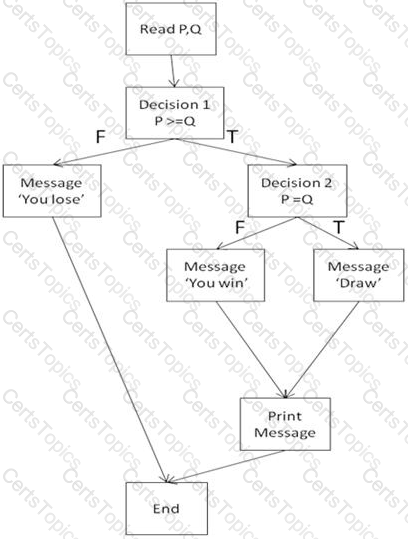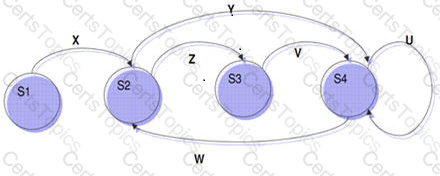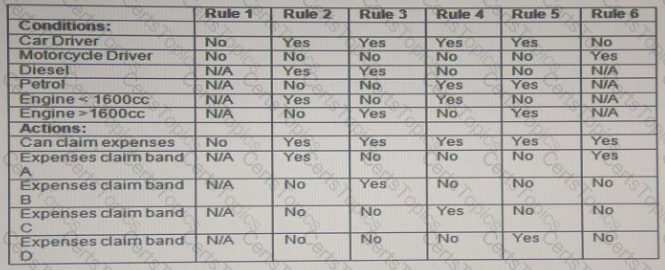Which of the following is the odd one out..?
When is testing complete?
Which of the following is a non-functional requirement?
Designing the test environment set-up and identifying any required infrastructure and tools are a part of which phase:
Which of the following is not a type of incremental testing approach?
Reviewing the test Basis is a part of which phase
The following statements relate to activities that are part of the fundamental test process.
i. Evaluating the testability of requirements.
ii. Repeating testing activities after changes.
iii. Designing the test environment set-up.
iv. Developing and prioritizing test cases.
v. Verifying the environment is set up correctly.
Which statement below is TRUE?
What can a risk-based approach to testing provide?
Independent Verification & Validation is:
Which of the following is true of iterative development?
Which option is part of the ‘implementation and execution’ area of the fundamental test process?
Testing should be stopped when:
Which of the following is the main purpose of the component build and integration strategy?
A new system is about to be developed. Which of the following functions has the highest level of risk?
Which statement below BEST describes non-functional testing?
Non-functional system testing includes:
Which of the following is usually the test basis for integration testing?
Which of the following is NOT part of configuration management..?
Consider the following statements about early test design:
i. Early test design can prevent fault multiplication
ii. Faults found during early test design are more expensive to fix
iii. Early test design can find faults
iv. Early test design can cause changes to the requirements
v. Early test design takes more effort
The cost of fixing a fault:
Which of the following has the typical formal review activities in the correct sequence?
For which of the following would maintenance testing be used?
Which of the following is correct?
Debugging is:
Which of the following best describes the purpose of non-functional testing?
Which of the following defects is most likely to be found by a test harness?
Which of the following statements are TRUE? A. Regression testing and acceptance testing are the same. B. Regression tests show if all defects have been resolved. C. Regression tests are typically well-suited for test automation. D. Regression tests are performed to find out if code changes have introduced or uncovered defects. E. Regression tests should be performed in integration testing.
Which of the following BEST describes the relationship between test planning and test execution? [K2]
An iPhone application identifies and counts all purchases of a particular product from a shopping website. The application incorrectly counts purchase attempts by including both failed attempts, and also those where the purchase was terminated by the user before completion. Testing has identified that the problem was located in the ‘purchase identification’ module, where the first stage in the purchasing process was counted, rather than a successful confirmed purchase.
Which of the following statements correctly identifies what has happened? [K2]
Testers are often seen as the bearer of unwanted news regarding defects. What are effective ways to improve the communication and relationship between testers and others?
a)Communicate factual information in a constructive way.
b)Try to understand how the other person feels and why they react the way they do.
c)Always outsource testing activities.
d)Never record information that could be used to apportion blame to an individual or team.
Which of the test cases below will exercise both outcomes from decision 2? [K3]
Refer to the exhibit

Which of the following would be appropriate test objectives for user acceptance testing of the first release of a new software product aimed at a general market and built using Agile methods? [K2]
a. To identify as many defects as possible
b. To maximise code coverage
c. To ensure the product works as expected
d. To assess the overall quality of the product
e. To determine the reliability of the product
Which type of review has the following main purposes:
discussing, making decisions, evaluating alternatives, finding defects, solving technical problems and checking conformance to specifications, plans, regulations, and standards?
Which of the following statements best characterises maintenance testing? [K2]
Which of the main activities of the fundamental test process does the task ‘verify the test environment set up is correct’ relate to? [K1]
“Experience based" test design techniques, typically...
Which of the following test case design techniques is white box (structure-based)? [K1]
Which of the following metrics could be used to monitor progress along with test preparation and execution? [K1]
It is recommended to perform exhaustive tests for covering all combinations of inputs and preconditions.
What is decision table testing?
Which statement correctly describes debugging? [K2]
Under which of the following circumstances is maintenance testing required? [K1]
Which of the following correctly states a limitation in the use of static analysis tools? [K1]
Which of the following accurately defines the integration testing test level? [K2]
A data driven approach to test automation design is best described as:
Consider the following pseudo code:
1. Begin
2. Input X, Y
3. If X > Y
4. __Print (X, ‘is greater than’, Y)
5. Else
6. __Print (Y, is greater than or equal to’, X)
7. EndIf
8. End
What is the minimum number of test cases required to guarantee both 100% statement coverage and 100% decision coverage?
Equivalence Partitioning is best defined as:
From the following list, which of the following apply to experience-based techniques? [K2]
a. Test cases are derived from a model of the problem to be solved or the software
b. Test cases are derived from the knowledge of the testers
c. The knowledge of testers, developers and users is used to drive testing
d. The internal structure of the code is used to derive test cases
What is a test condition?
Which of the following statements about software development models is most accurate? [K1]
Which of the following is a role of a formal review?[K1]
Refer to the exhibit

Given the following State Transition diagram, match the test cases below with the relevant set of state transitions.
(i)X-Z-V-W
(ii)W-Y-U-U
What other details should be included in the following incident report when it is first submitted?
Date of Issue: 23/11/05
Severity: P1
Build: Version15.6
Details: Expected field to be limited to 15 chars, able to enter 27
System testing is:
Your task is to compile a test execution schedule for the current release of software.
The system specification states the following logical dependencies:
• An admin user must create/amend/delete a standard user.
• A standard user is necessary to perform all other actions.
The test plan requires that re-tests must be performed first, followed by the highest priority tests. To save time, the test plan states that tests should be scheduled to create test data for the subsequent tests in the schedule.
The following test cases have been designed, with an indication of priority (1 being the highest priority) and whether the test has previously failed.

Which test execution schedule meets the test plan requirements and logical dependencies?
Which of the following does NOT represent one of the three triggers for maintenance testing an operational system?
A booking system for a city bus service prices its fares according to the time of travel:
• Peak-time tariff starts at 0600 and finishes at 1000 am
• Off-peak tariff applies during all other times of service
• The bus service does not operate between 2300 and the start of the next day’s peak service
Note that all times mentioned are inclusive.
When applying the equivalence partitioning test design technique, which of the following options, shows test case inputs that each fall into a different equivalence partition?
A system requirement states that up to 100 users should be able to carry out a transaction, with responses returned within 5 seconds.
What type of non-functional testing would you carry out to verify these requirements?
Which of the following activities is appropriate to the test planning stage?
Which option BEST describes how the level of risk is determined?

The decision table above shows a company's fuel expenses structure.
Which of the following Test Cases based on the decision table are Valid?
Test Case 1:
An employee who is not a car or motorcycle driver attempts to claim fuel expenses. Expected result: Expense claim not allowed.
Test Case 2:
An employee who drives a 1700cc diesel car attempts to claim fuel expenses. Expected result: Expense claim accepted at band C.
Test Case 3:
An employee who rides a motorcycle attempts to claim fuel expenses. Expected result: Expense claim accepted at band A.
Which of the following would be a good test technique to use when under severe time pressure?
Which of the following options explain why it is often beneficial to have an independent test function in an organisation?
Testing effort can depend on a number of factors, which one of following is MOST likely to impact the amount of effort required?
Which of the following type of defect would NOT be typically found by using a static analysis tool?
Which of the following is a defect that is more likely to be found by a static analysis tool than by other testing techniques?
Your company is developing a system with complex business rules and many branches in the structure of its code components. You need to choose one black box technique and one white box technique for test case design.
Which one of the following offers the BEST choice?
Why is measurement of code coverage Important?
The following Test Cases have been created for a simple web-based airline booking system.
Test Case 1: Search for an item Available Flights
Test Case 2: View selected item in My Flights
Test Case 3: Login to the system: Login is accepted
Test Case 4: Select an available flight: item added to My Flights
Test Case 5: Print confirmation receipt, then exit
Test Case 6: In My Flights, confirm details and book flight
Which of the following is the correct logical order for the test cases?
Which of the following is a white-box test technique?
You are examining a document which gives the precise steps needed in order to execute a test.
What is the correct definition of this document?
Which of the following is NOT a valid objective of testing?
When considering the roles of test leader and tester, which of the following tasks would NOT typically be performed by a tester?
Which of the following options describe the causal chain in the correct sequence?

In the above State Table, which of the following represents an invalid transition?
Which of the following is NOT a valid use of decision coverage?
Which of the following would achieve the HIGHEST level of testing independence for a project's test level?
Which of the following represents good testing practice for testers, irrespective of the software lifecycle model used?
Which of the following would you NOT expect to see on an incident report from test execution?
You have been asked to improve the way test automation tools are being used in your company.
Which one of the following is the BEST approach?
During which stage of the fundamental test process is the testability of requirements evaluated?